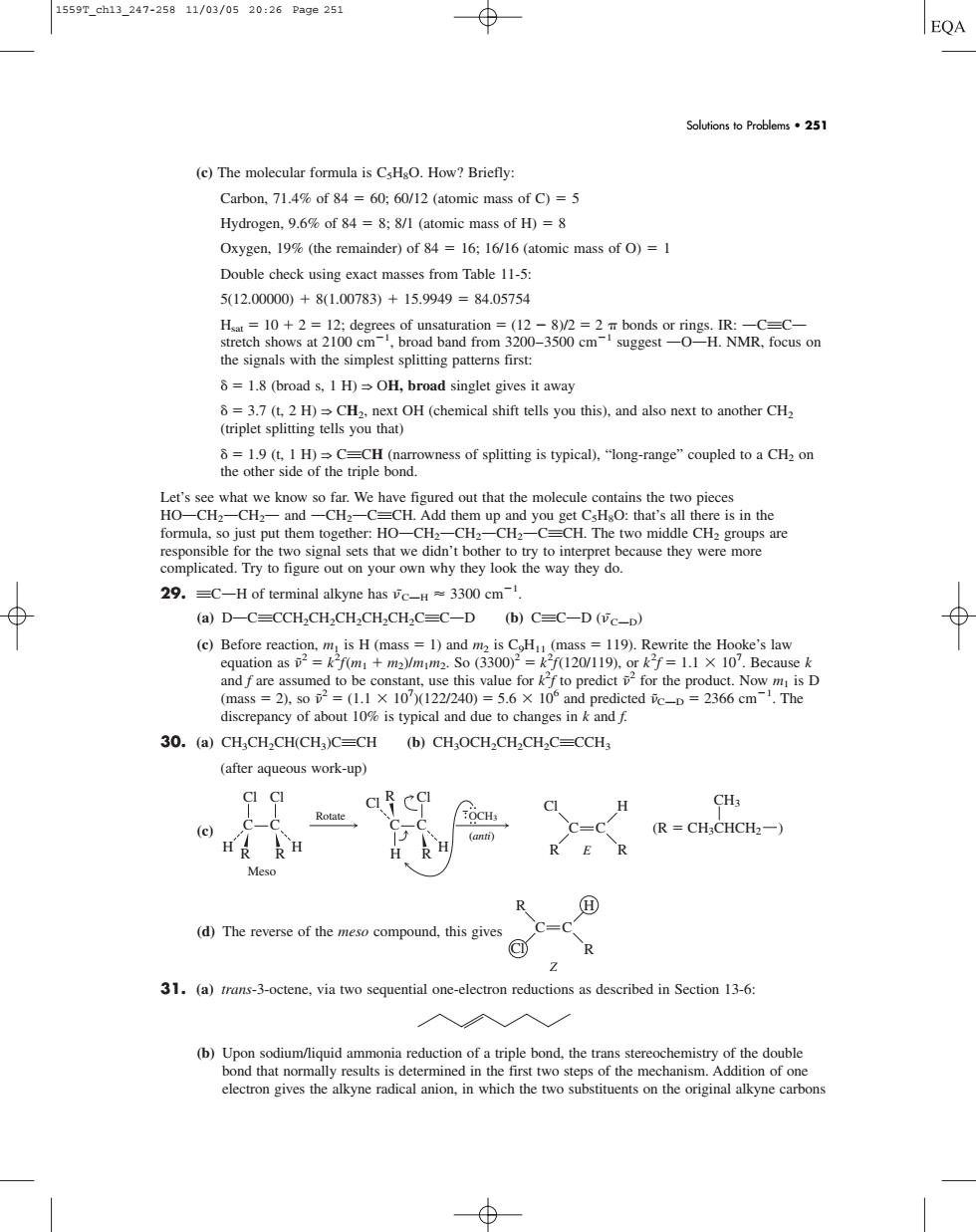正在加载图片...

1559T_ch13_247-25811/03/0520:26Pa9e251 ⊕ EQA Solutions to Problems.251 (e)The molecular formula is CsHO.How?Briefly Carbon.71.4%of 84 60:60/12 (atomic mass of C)=5 Hydrogen.9.6%of 84 =8:8/1 (atomic mass of H)=8 Oxygen,19%(the remainder)of 84=16:16/16(atomic mass of ) Double check using exact masses from Table 11-5 512.00000)+81.00783)+15.9949=84.05754 plest splittin suggest =1.8 (broad s,1 HOH,broad singlet gives it away 8=3.7 (t.2 H)CH2.next OH (chemical shift tells you this).and also next to another CH2 (triplet splitting tells you that) 6=19(t=CH(na owness of spliting is typical)."long-range"coupled to a CH2o the other side of the triple bond. thar'srsn the formula s just put them together:HO-CH CH CH2 29 =C-H of terminal alkyne has vc-3300 cm (a)D-C=CCH2CH2CH2CH2CH2C=C-D (b)C=C-D(vc-p) 30.(a)CH,CH2CH(CH])C=CH (b)CH,OCH,CH,CH2C=CCH, (after aqueous work-up) (R=CHCHCH,-) Mes R (d)The reverse of the meso compound,this gives @ 31.(a)frans-3-octene.via two sequential one-electron reductions as described in Section 13-6: 入入入 (b)Upon sodium/liquid amn duction of a triple bond.th f the doubl electron gives the alkyne radical anion,in which the two substituents on the original alkyne carbons (c) The molecular formula is C5H8O. How? Briefly: Carbon, 71.4% of 84 60; 60/12 (atomic mass of C) 5 Hydrogen, 9.6% of 84 8; 8/1 (atomic mass of H) 8 Oxygen, 19% (the remainder) of 84 16; 16/16 (atomic mass of O) 1 Double check using exact masses from Table 11-5: 5(12.00000) 8(1.00783) 15.9949 84.05754 Hsat 10 2 12; degrees of unsaturation (12 8)/2 2 bonds or rings. IR: OCqCO stretch shows at 2100 cm1 , broad band from 3200–3500 cm1 suggest OOOH. NMR, focus on the signals with the simplest splitting patterns first: 1.8 (broad s, 1 H) F OH, broad singlet gives it away 3.7 (t, 2 H) F CH2, next OH (chemical shift tells you this), and also next to another CH2 (triplet splitting tells you that) 1.9 (t, 1 H) F CqCH (narrowness of splitting is typical), “long-range” coupled to a CH2 on the other side of the triple bond. Let’s see what we know so far. We have figured out that the molecule contains the two pieces HOOCH2OCH2O and OCH2OCqCH. Add them up and you get C5H8O: that’s all there is in the formula, so just put them together: HOOCH2OCH2OCH2OCqCH. The two middle CH2 groups are responsible for the two signal sets that we didn’t bother to try to interpret because they were more complicated. Try to figure out on your own why they look the way they do. 29. qCOH of terminal alkyne has ˜COH 3300 cm1 . (a) DOCqCCH2CH2CH2CH2CH2CqCOD (b) CqCOD (˜COD) (c) Before reaction, m1 is H (mass 1) and m2 is C9H11 (mass 119). Rewrite the Hooke’s law equation as ˜ 2 k2 f(m1 m2)/m1m2. So (3300)2 k2 f(120/119), or k2 f 1.1 107 . Because k and f are assumed to be constant, use this value for k2 f to predict ˜ 2 for the product. Now m1 is D (mass 2), so ˜ 2 (1.1 107 )(122/240) 5.6 106 and predicted ˜COD 2366 cm1 . The discrepancy of about 10% is typical and due to changes in k and f. 30. (a) CH3CH2CH(CH3)CqCH (b) CH3OCH2CH2CH2CqCCH3 (after aqueous work-up) (c) (d) The reverse of the meso compound, this gives 31. (a) trans-3-octene, via two sequential one-electron reductions as described in Section 13-6: (b) Upon sodium/liquid ammonia reduction of a triple bond, the trans stereochemistry of the double bond that normally results is determined in the first two steps of the mechanism. Addition of one electron gives the alkyne radical anion, in which the two substituents on the original alkyne carbons Z Cl C H C R R E Cl C H C R R ) CH3 (R CH3CHCH2 Rotate Meso Cl C H R Cl C H R H Cl R C Cl C H R OCH3 (anti) Solutions to Problems • 251 1559T_ch13_247-258 11/03/05 20:26 Page 251����������